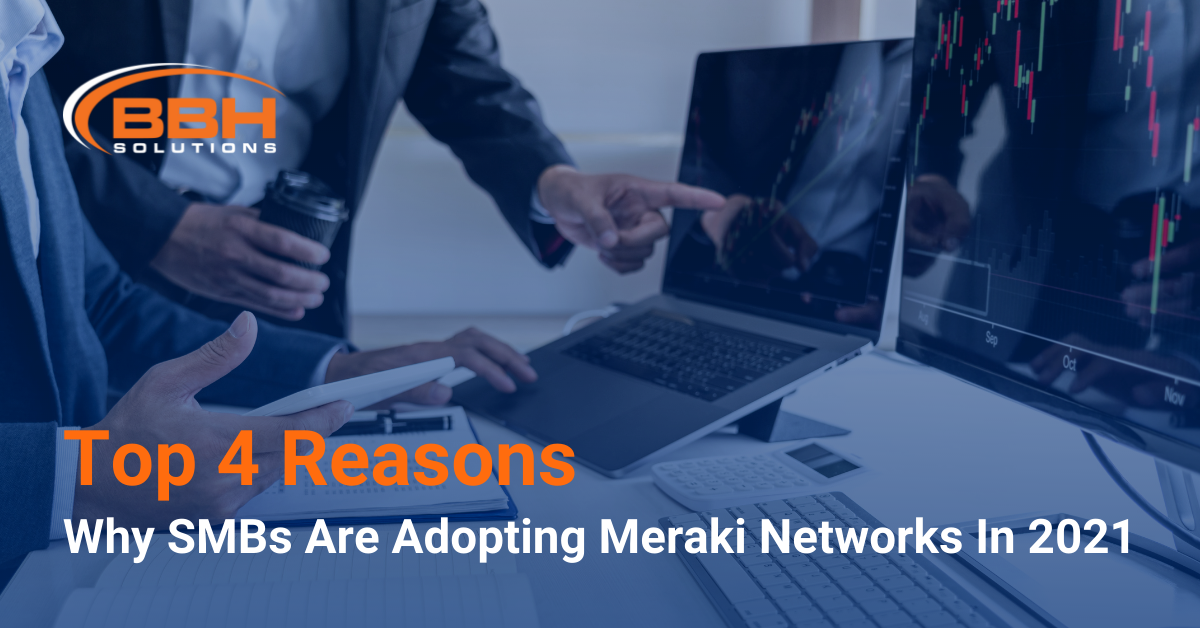Small to Medium Businesses (SMBs) are leveraging the cloud more than ever to better suit the needs of their hybrid or fully remote workforces. Cloud integrated collaboration tools such as Microsoft 365 and Teams helped remote workers seamlessly stay in touch with colleagues and customers during the most troubling times of the COVID-19 pandemic. Secure remote connectivity and the ability to access shared files and data are prerequisites for the successful virtual workforce. Networks supported by Cisco Meraki provide rapidly deployable, secure, and streamlined remote management connectivity for the modern workforce.
Here are four reasons why SMBs are adopting Meraki networks in 2021.
Simple, Yet Powerful Features
With Meraki, the cloud dashboard becomes the centralized hub for all network equipment across your organization.
With the intuitive cloud portal, there are no command lines required to access the advanced settings of your network infrastructure. Everything from configuration to deployment can be done in the rich interface, which can be accessed from any browser.
However, don’t let the seamless interface fool you; Meraki offers robust, customizable features for all its devices and management. Some of the most notable features available in the Meraki portal include:
- Zero-touch provisioning - Configure access points, switches, and other devices without ever having to touch the device.
- Pre-configuration options - Build templates that can be pushed out across your organization in a matter of minutes.
- Advanced Malware Protection (AMP) - Security functions that safeguard your environment from cybersecurity attacks.
- Cisco AnyConnect VPN – Support for secure VPN client that allows remote staff to connect to corporate resources.
- Mobile device management - Protect and manage all corporate laptops, tablets, and mobile devices with one intuitive dashboard.
Scalability
Because Meraki offers cloud-based deployment, your infrastructure can grow with your business as your needs change. Adding or removing devices requires a simple licensing change and deploying them is simpler than ever with zero-touch provisioning.
Further, device cloning, templates and automation allow IT teams to deploy new infrastructure without having to start the build process from scratch. No matter how large or small your infrastructure, it can all be managed via the main Meraki Dashboard.
Security
Networks are more vulnerable than ever due to the expanded surface area of dispersed, connected devices. With so many devices connecting to company resources from outside the organization, security must be top of mind for SMBs.
The Meraki cloud dashboard provides full visibility across the network so administrators can see how their environment is performing in real-time, allowing them to make adjustments on the fly.
Further, Cisco Meraki is backed by Talos, Cisco’s threat intelligence group, which is one of the largest in the world. Talos cybersecurity researchers are constantly finding new threats and updating Cisco and Meraki equipment to block those threats. With Meraki, your software and firmware regularly and automatically update.
Cost Savings
One of the strongest cases for adopting the Cisco Meraki platform is its simplicity. Meraki’s central, easy-to-manage interface allows IT teams to spend less time with tedious configurations and manual tasks more time on critical tasks. Meraki also enables SMBs to transition to the cloud, which helps cut the costs of maintaining legacy assets and adopt a more intuitive, streamlined and cost-effective infrastructure.
The Meraki Difference
Want to learn more about how Cisco Meraki is revolutionizing the way organizations are maintaining their network, security, and wireless infrastructure?
Visit our full Meraki overview to get the full rundown on Meraki for small businesses today.


